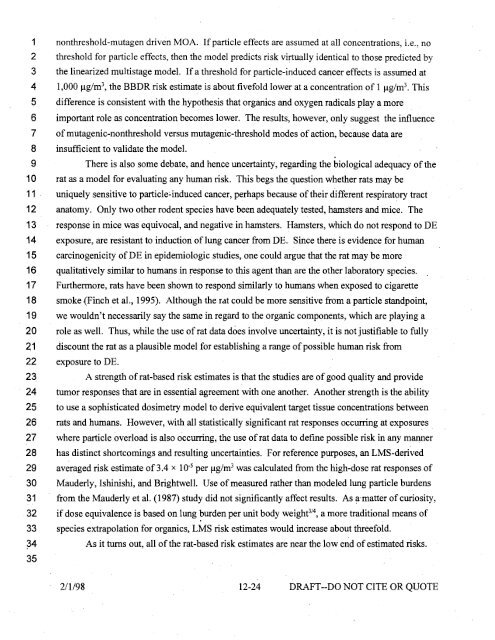Health Assessment Document for Diesel Emissions - NSCEP | US ...
Health Assessment Document for Diesel Emissions - NSCEP | US ...
Health Assessment Document for Diesel Emissions - NSCEP | US ...
You also want an ePaper? Increase the reach of your titles
YUMPU automatically turns print PDFs into web optimized ePapers that Google loves.
1 nonthreshold-mutagen driven MOA. If particle effects are assumed at all concentrations, i.e., no<br />
2 threshold <strong>for</strong> particle effects, then the model predicts risk virtually identical to those predicted by<br />
3 the linearized multistage model. If a threshold <strong>for</strong> particle-induced cancer effects is assumed at<br />
4 1,000 J.l.g/m 3 , the BBDR risk estimate is about fivefold lower at a concentration of 1 J.l.g/m 3 . This<br />
5 difference is consistent with the hypothesis that organics and oxygen radicals play a more<br />
6 important role as concentration becomes lower. The results, however, only suggest the influence<br />
7 of mutagenic-nonthreshold versus mutagenic-threshold modes of action, because data are<br />
8 insufficient to validate the model.<br />
9 There is also some debate, and hence uncertainty, regarding the biological adequacy of the<br />
1 0 rat as a model <strong>for</strong> evaluating any human risk. This begs the question whether rats may be<br />
11 . uniquely sensitive to particle:..induced cancer, perhaps because of their different respiratory tract<br />
12 anatomy. Only two other rodent species have been adequately tested, hamsters and mice. The<br />
13 response in mice was equivocal, and negative in hamsters. Hamsters, which do not respond to DE<br />
14 exposure, are resistant to induction oflung cancer from DE. Since there is evidence <strong>for</strong> human<br />
15 carcinogenicity of DE in epidemiologic studies, one could argue that the rat may be more<br />
16 qualitatively similar to humans in response to this agent than are the other laboratory species. .<br />
17 Furthermore, rats have been shown to respond similarly to humans when exposed to cigarette<br />
18 smoke {Finch et al., 1995). Although the rat could be more sensitive from a particle standpoint,<br />
19 we wouldn't necessarily say the same in regard to the organic components, which are playing a<br />
20 role as well. Thus, while the use of rat data does involve uncertainty, it is not justifiable to fully<br />
21 discount the rat as a plausible model <strong>for</strong> establishing a range of possible human risk from<br />
22 exposure to DE.<br />
23 A strength of rat-based risk estimates is that the studies are of good quality and provide<br />
24 tumor responses that are in essential agreement with one another. Another strength is the ability<br />
25 to use a sophisticated dosimetry model to derive equivalent target tissue concentrations between<br />
26 rats and humans. However, with all statistically significant rat responses occurring at exposures<br />
27 where particle overload is also occurring, the use of rat data to define possible risk in any manner<br />
28 has distinct shortcomings and resulting uncertainties. For reference purposes, an LMS-derived<br />
29 averaged risk estimate of 3.4 x 1 o-s per J.l.g/m 3 was calculated from the high-dose rat responses of<br />
30 Mauderly, Ishinishi, and Brightwell. Use of measured rather than modeled lung particle burdens<br />
31 from the Mauderly et al. (1987) study did not significantly affect results. As a matter of curiosity,<br />
32 if dose equivalence is based on lung burden per unit body weight 31 \ a more traditional means of<br />
33 species extrapolation <strong>for</strong> organics, LMS risk estimates would increase about threefold.<br />
;34 As it turns out, all of the rat-based risk estimates are near the low end of estimated risks.<br />
35<br />
2/1/98 12-24 DRAFT --DO NOT CITE OR QUOTE















